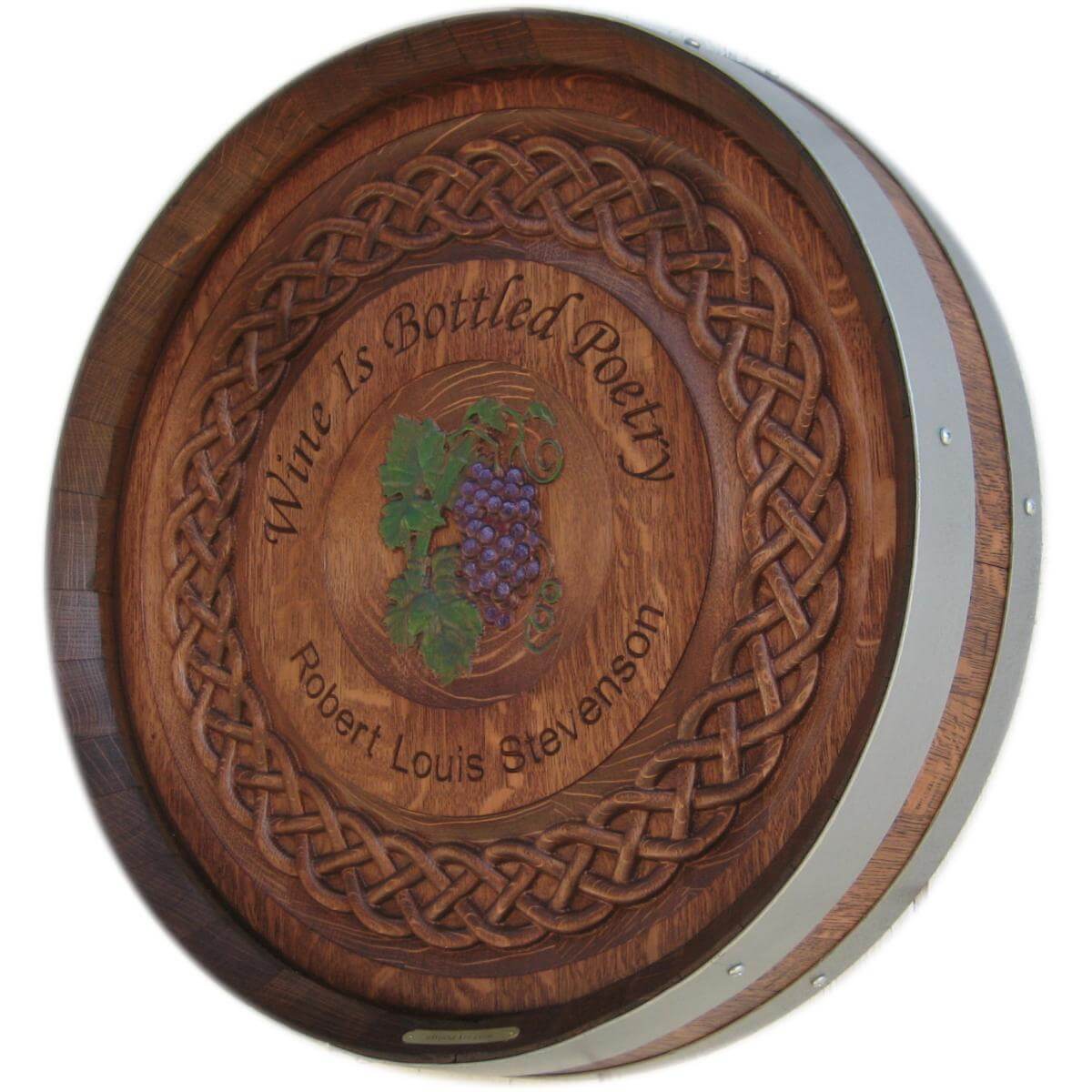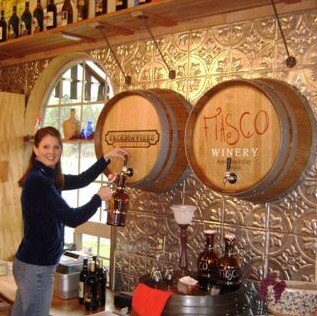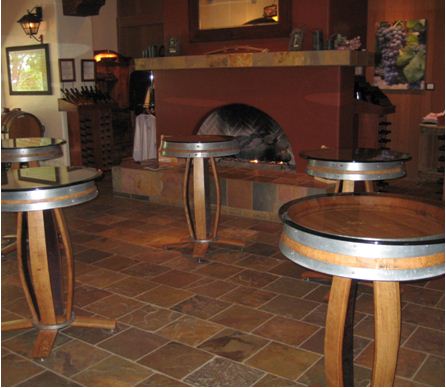Wine Barrel Carvings In Hospitality Wine Decor

Wine barrels have been around a LONG time. Wine lovers have always been intrigued with their esthetics and with incorporating them into various forms of “wine art” or “wood art” after they are retired from winemaking. They are still hand-made today by skilled artisans from the finest, clearest, most beautiful quarter-sawn oak that money can buy. Recycling the highest quality barrels into wine art is their best & highest use – way better & higher than turning them into planter boxes.

Hundreds of years ago it was a sign of status for old world wineries to show off elaborate barrel carvings made from their retired barrels. They served as signage at winery entrances, as well as decorative displays inside, depicting a wide range of subject matter – from the owner’s favorite vintage or pastime, to landscapes and wildlife scenes, to bacchanalian celebrations.
This old world tradition nearly faded away until being revived by a handful of new world artisans. The largest collection of modern day barrel carvings in the world is on display at the beautiful Sebastiani Winery in Sonoma California. It includes hundreds of hand-carved barrels of all sizes plus many carved doors, posts and beams inside the winery. It is all the work of one man, Earle Brown, who dedicated much of his life to creating it under the patronage of owner August Sebastiani.
The recent rapid growth in interest in wine has lead to a corresponding spike in interest in wine décor for the hospitality industry (restaurants, wine bars, tasting rooms, hotels, events), as well as for home wine cellars and bars. A few modern wood artisans are skilled at creating stunning custom carvings from high quality retired oak wine barrels. One company, eWoodArt.com, leverages state-of-the-art computer aided design and manufacturing technology to help cost-effectively produce barrel carvings for homes and businesses – often working closely with design firms who integrate them into complete wine décor projects.
One such recent project is a large 30-barrel “pyramid stack” for the Wine Cellar dining room in the elegant new Perry’s Steakhouse & Grille in Dallas, Texas shown at the top of this article. Lead designer, Charles Lambert, describes the project:
“In the Preliminary Design process Mr. Perry (President & CEO, Perry’s Restaurants) wanted a recessed private dining room that took on the feel of an old Wine Cellar. He wanted a room that was warm and interesting, but also different from anything they have ever had previously. We incorporated stone walls, a vintage door, and mosaic marble ceiling with wood beams. We decided that it would make it more authentic if we could find real, used wine barrels. After discovering how large these are, we quickly realized that there was not enough space to do a full wall of side stacked barrels.
We searched for a supplier of these barrels that we could have cut in half. Thankfully, we quickly came across eWoodArt.com ! They had already perfected the concept and had the bonus capability to carve the various winery logos onto the ends of the barrel heads.
The Wine Buyer at Perry’s invited 30 of their most popular winemakers to participate in the project and to supply their digital artwork.
When we ordered the barrel heads, Tom was very instrumental in guiding us in the best direction that would support our authentic vision. He suggested that we not stain all the barrels the same, so we incorporated several stain colors. About every week we would get a shipment and we would all gather around at it’s unveiling with great surprise and awe.
When Mr. Perry first saw the completed room, he said “I LOVE IT! The barrels really make this Wine Cellar the room that I had envisioned.” In fact, at the grand opening celebration, Mr. Perry elected to host his family and friends in this room.
We too are very pleased with the unique outcome. And with 2 more new restaurants on the drawing board, we hope to have the opportunity to work with eWoodArt again!”

As highlighted above, standard-size wine barrels are quite large (approx. 2′ diameter at the ends by 3’ long), so it is usually impractical to display full barrels. For this reason, most barrel carvings are made from the cut-off barrel heads – including anywhere from about 4-12” of surrounding hoops and staves. Shown here is a richly carved and hand painted “tenth barrel carving” which is about 5 inches deep.

When equipped with spigots and behind-the-wall or under-the-counter gas-push systems, barrel head carvings are being put to work dispensing wine or beer on tap in wineries, tasting rooms, bars and brew pubs. They fit perfectly into the growing “wine-on-tap” movement where bars dispense wine by the glass or carafe, and where wineries sell bulk wine in re-fillable take home jugs. Shown here are a pair of 12″ deep wine-on-tap barrel heads used in the Tasting Room of Jacksonville and Fiasco Wineries in their bulk wine sales program.

The “tenth barrel” configuration also makes a perfect table top when mounted on a stand made of barrel staves or cast iron. Shown to the right are several bar height “tasting tables” in the Bridlewood Winery tasting room (shown with glass tops removed).
From a production perspective, there are several key things to consider to ensure the highest degree of quality and beauty. First, only the finest barrels are suitable for barrel carving. These use solid 1+ inch thick, quarter-sawn oak, which results in the most stunning look when deeply carved and finished with a fine-furniture grade finish. Tongue-in-groove jointed head staves are far superior for deep carvings, as butt-jointed heads have internal dowels. After being sawed off from the barrel, each head must be disassembled and glued together so that cracks don’t open up as the large flat head expands and contracts with changing moisture content. A round plywood backing is glued into a recess milled around the back inside perimeter to give the piece maximum strength and durability. Hoops are reconditioned and painted (typically with one of the new “hammered metallic” finishes) to restore the like-new look or simulate another metal like the hammered copper hoops on the Bridlewood tables. Of course, for those who prefer a more rustic look, some of these steps may be adjusted.
Carvings can be hand-painted if the customer desires and certainly most businesses want their logo carvings painted in the company colors. However, we generally encourage people to use paint sparingly as natural looking stains show off the innate beauty of the wood, while paint tends to hide it. And because the carvings cut across the wood grain to varying degrees, stain soaks into the grain differently, resulting in a very richly textured 3D look. We sometimes also apply glazes to further enhance the feeling of depth.
Interest in wine, the wine lifestyle and wine décor still has a lot of growth ahead – especially in North America as it catches up to where it is in Europe. We expect to see the revival of the time honored folk art of barrel carving to continue to gather momentum in the hospitality industry, in wine-oriented businesses and in the homes of wine lovers.


Leave a Reply